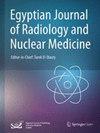Comparison between the diagnostic utility of three-dimensional fluid attenuated inversion recovery (3D FLAIR) and three dimensional double inversion recovery (3D DIR) magnetic resonance sequences in the assessment of overall load of multiple sclerosis lesions in the brain
IF 0.5
Q4 RADIOLOGY, NUCLEAR MEDICINE & MEDICAL IMAGING
Egyptian Journal of Radiology and Nuclear Medicine
Pub Date : 2024-08-12
DOI:10.1186/s43055-024-01327-7
引用次数: 0
Abstract
Multiple sclerosis (MS) is a complex CNS demyelinating disease. Assessment of MS plaques in specific anatomic locations in the brain was challenging to detect by conventional MRI sequences. So, this study aimed to compare the diagnostic accuracy of 3D FLAIR (Fluid attenuation inversion recovery), or 3D DIR (Double inversion recovery) sequences to conventional 2D FLAIR and T2 sequences in detecting MS plaques in different anatomic sites, as well as counting the total lesion burden. A comparative cross-sectional study enrolled 30 MS patients on the basis of McDonald’s criteria 2017. All participants underwent a brain MRI study including 3D FLAIR or 3D DIR sequences, conventional 2D FLAIR, and T2 sequences. No statistically significant difference between the 3D DIR and 3D FLAIR in total lesion (plaque) burden results; however, when each is compared to the conventional ones, both are superior. 3D FLAIR detected the most significant number of plaques in the periventricular region, followed by 2D FLAIR and T2W sequences, with 3D DIR being the least accurate in this region. Meanwhile, 3D DIR was the most precise and can detect a statistically significant number of cortical plaques compared to the 3D FLAIR and the conventional sequences. No statistically significant results on which sequence is best in regard to infratentorial plaque detection. 3D FLAIR and 3D DIR were superior to 2D FLAIR and T2 sequences in detecting overall lesion burden in MS. Moreover, the 3D DIR sequence was the most precise in the detection of the cortical plaques.比较三维流体衰减反转恢复(3D FLAIR)和三维双反转恢复(3D DIR)磁共振序列在评估脑部多发性硬化病灶总体负荷方面的诊断效用
多发性硬化症(MS)是一种复杂的中枢神经系统脱髓鞘疾病。通过传统的磁共振成像序列来评估大脑特定解剖位置的多发性硬化斑块具有挑战性。因此,本研究旨在比较三维 FLAIR(流体衰减反转恢复)或三维 DIR(双反转恢复)序列与传统的二维 FLAIR 和 T2 序列在检测不同解剖部位的 MS 斑块以及计算总病变负荷方面的诊断准确性。一项横断面比较研究根据2017年麦克唐纳标准招募了30名多发性硬化症患者。所有参与者都接受了脑部核磁共振成像研究,包括三维 FLAIR 或三维 DIR 序列、传统的二维 FLAIR 和 T2 序列。三维 DIR 和三维 FLAIR 在总病变(斑块)负荷结果上没有统计学意义上的明显差异;但是,与传统的三维 DIR 和三维 FLAIR 相比,两者都更胜一筹。三维 FLAIR 在脑室周围区域检测到的斑块数量最多,其次是二维 FLAIR 和 T2W 序列,而三维 DIR 在该区域的准确性最低。同时,与三维 FLAIR 序列和传统序列相比,三维 DIR 最为精确,能检测出数量可观的皮质斑块。至于哪种序列能最好地检测到幕下斑块,在统计学上没有明显的结果。三维 FLAIR 和三维 DIR 在检测多发性硬化症总体病变负荷方面优于二维 FLAIR 和 T2 序列。此外,三维 DIR 序列在检测皮质斑块方面最为精确。
本文章由计算机程序翻译,如有差异,请以英文原文为准。
求助全文
约1分钟内获得全文
求助全文
来源期刊

Egyptian Journal of Radiology and Nuclear Medicine
Medicine-Radiology, Nuclear Medicine and Imaging
CiteScore
1.70
自引率
10.00%
发文量
233
审稿时长
27 weeks
 求助内容:
求助内容: 应助结果提醒方式:
应助结果提醒方式:


